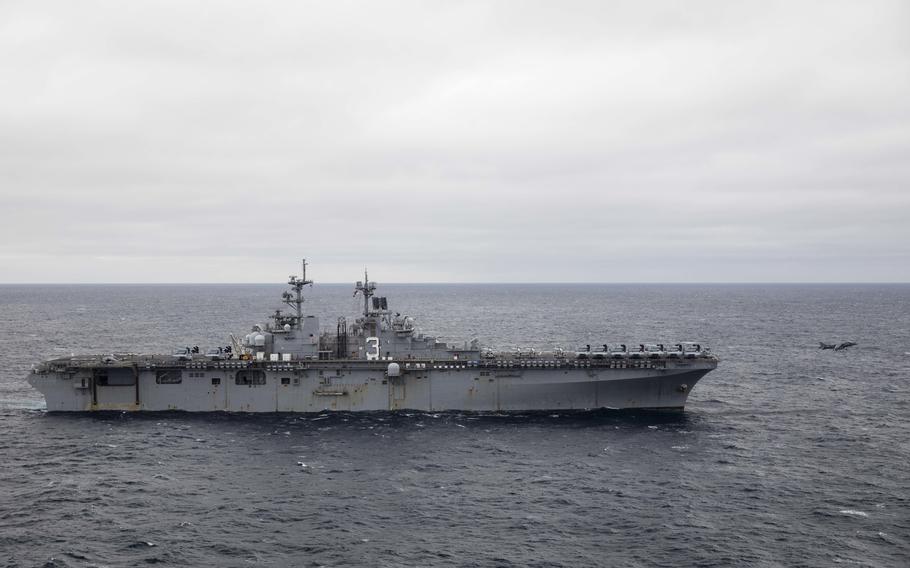
An AV-8B Harrier, attached to the 22nd Marine Expeditionary Unit, takes off from the flight deck of the Wasp-class amphibious assault ship USS Kearsarge during Northern Viking 22 (LHD 3), April 4, 2022. (Jesse Schwab/U.S. Navy)
(Tribune News Service) — Roaring up the 19-mile Hvalfjorour (Whale Ford) in Iceland is a different kind of challenge than guiding a Navy hovercraft onto a beach at Fort Story. But testing how sailors cope with a rocky shore and the high winds and rough seas of the North Atlantic was the focus of the Norfolk-based USS Kearsarge amphibious ready group and its Marines.
It marked the first time the U.S. led one of NATO’s Northern Viking exercises around alliance member Iceland, and reflects a much-heightened interest in the so called “Greenland-Iceland-United Kingdom gap” — the routes Russian submarines take to reach the high seas from their main base in Murmansk.
“When landing on Hvalfjorour Beach, we saw large rocks that some would consider boulders,” said Senior Chief Mate Aaron T. Richter, whose job it is to safely land Marines of the 22nd Marine Expeditionary Unit that deployed with the Kearsarge group last month.
“The main challenge is navigating the craft to a safe landing position while not landing the craft on top of large rocks.
“LCACs have landing rails that the craft sits on when off cushion. The rocks that are scattered across the beach greatly exceed the height of the rails. If we don’t position the craft carefully, we could cause significant damage to the craft. The winds that come off the coast of Iceland proved a challenge of its own.”
For USS Kearsarge, USS Arlington and USS Gunston Hall, the Hampton Roads-based ships of the amphibious ready group, those winds and the rough seas off Iceland meant coming in closer to shore before launching hovercraft from the well deck, experiencing conditions they just don’t see on U.S. shores.
“Training in these colder temperatures challenged the ARG-MEU to adapt and thrive,” said Capt. David Guluzian, commander of the Kearsarge ready group.
He said the Icelandic and Norwegian sailors who joined the Northern Viking exercise shared their expertise.
“Wearing extra layers of clothes and protective gear, properly maintaining equipment, and planning around Arctic storms requires the right type of procedures and capabilities shared by our Arctic partners,” Guluzian said.
“For ship-to-shore or ship-to-ship operations, sailors and Marines wear anti-exposure dry-suits before they board a helicopter, landing craft air cushion, or Rigid Hull Inflatable Boat (small boat) to mitigate any risk.”
The ready group’s ships, aircraft and LCACs also installed equipment designed for anti-icing, he said.
During the exercise, the Kearsarge group and the 22 MEU operated with the Virginia-class submarine USS John Warner, P-8 maritime patrol aircraft based at Kevlavik Air Station in Iceland along with forces from France, Germany, Iceland, Norway, Portugal and Great Britain.
USS Arlington embarked members of the Royal Marines’ 42 Commando unit during the exercise. Those commandos work with Marines from 22 MEU and with the Icelandic Coast Guard on exercises testing boarding, searching and seizure of smugglers’ craft, as well as simulated raids, where LCACs and CH-53 helicopters landed the Marines and commandos on a ship-to-shore movement.
The Kearsarge group and NATO allies worked through humanitarian assistance and medical assistance drills, maritime search and rescue, air defense scenarios and anti-submarine warfare.
The U.S. Navy’s operations from Iceland played a vital role in World War II, when seaplane patrols kept Nazi U-boat attacks on convoys in check.
“The strong relationship between the U.S. and Iceland, especially in the maritime, dates back more than 70 years,” said Vice Adm. Gene Black, commander, U.S. Sixth Fleet, which took the lead in this year’s Northern Viking exercise.
Besides Kearsarge, Arlington and Gunston Hall, Hampton Roads units participating in the exercise included Fleet Surgical Team 2, Tactical Air Control Squadron 22, Helicopter Sea Combat Squadron 28, Assault Craft Unit 2, Assault Craft Unit 4, Naval Beach Group 2 and Beach Master Unit 2 and USS John Warner.
©2022 Daily Press.
Visit dailypress.com.
Distributed by Tribune Content Agency, LLC.